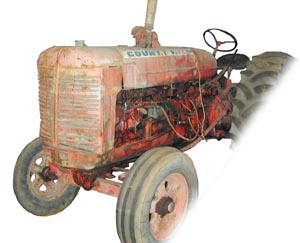Farmall, W9 / WD9, 1944, Yavne
Originally a W9 model, this tractor had metal wheels. After its engine was replaced with a diesel one, it was renamed WD9 to align with existing standard naming conventions.
The Story of an Old Kibbutz Member Named W9
By Mordechai Bar Droma
I've been at Kibbutz Yavne since 1944. I'm 62 now and I've moved to my new home. Here, you can calmly listen to some of my fascinating stories. The Jewish Agency brought me, and a few months later, they brought my brother too.
Both of us arrived with iron wheels, a kerosene engine, and both gasoline and kerosene tanks. They'd start me with a hand crank. That's how I was manufactured in the International factories in the U.S.A.
Here's my story: I arrived on a ship from America during World War II. I disembarked at the Port of Haifa. Customs inspectors looked at me with amazement. From the gates of Haifa Port, I traveled on my iron wheels toward Kibbutz Yavne. I spent my entire life there until I retired. All along the way, the pioneers of Eretz Israel looked at me strangely. They were already waiting for me at the kibbutz gate.
All the kibbutz members cheered me with applause. My work organizer was the head of agriculture – the late Menachem Bar Droma – from whom I learned how much to work, and from Meir Bar Shalom, how to work. With great respect, they showed me the plow and also the team of mechanics who would take care of me – Bob and the late Meir Friedman. Years later, Bob, who should live a long life, replaced my kerosene engine with a diesel engine. They also installed a device called a starter, which replaced the hand crank we called a "manuela." With that manuela, we injured many members when they tried in vain to turn my engine on an empty stomach. The engine would then turn backward, and they called it "back-fire." Many members were injured by me, and they struggled in the winter days until they managed to start me. I worked outside in the fields of the Arabs in "Yavne," "Basheet," and "Sukrir" near "Aswad" – today Ashdod.
I earned a lot of money from the Arabs who welcomed me into their villages with the characteristic reception of that time. I even slept in their homes. Me and the Yavne farmers who drove me: Shimon Degani and Gedalya Ditur.
Here's another story: There were many areas of black soil. One day, a new tractor driver got on me and started plowing the land. Suddenly, he steered me over a beehive. A cloud of bees stuck to the guy, and the poor fellow ran away from me without stopping me. I continued in the furrow until I reached a wadi, where I overturned, was severely damaged in my front wheels, and was put out of commission. For six Israeli pounds, they brought an English vehicle officer with a tow truck who turned me back onto my wheels.
They even fed me in the kibbutz dining hall – with respect. That's how my days passed.
Meanwhile, in 1945, the Agency managers heard that I was injured and sent my twin brother to the kibbutz. He also had a flywheel on the outside of his body, and from it, they operated a generator with a belt.
After the War of Independence, I continued to work the kibbutz fields – about 150,000 dunams. Every furrow was kilometers long from the Ashdod junction to Kannot. I pulled combines in the Negev fields, in the Sa'ad area, Beersheba, and the temporary fields of Kibbutz Yavne. This was all on the rubber wheels that they sent me from my birthplace in the U.S.A. In my old age, they placed a crane on me and thus moved me to my new home. I didn't disappoint the mechanics: I had excellent health until this very day. Well done! My friends at the kibbutz told me that our longing for each other is still mutual.
